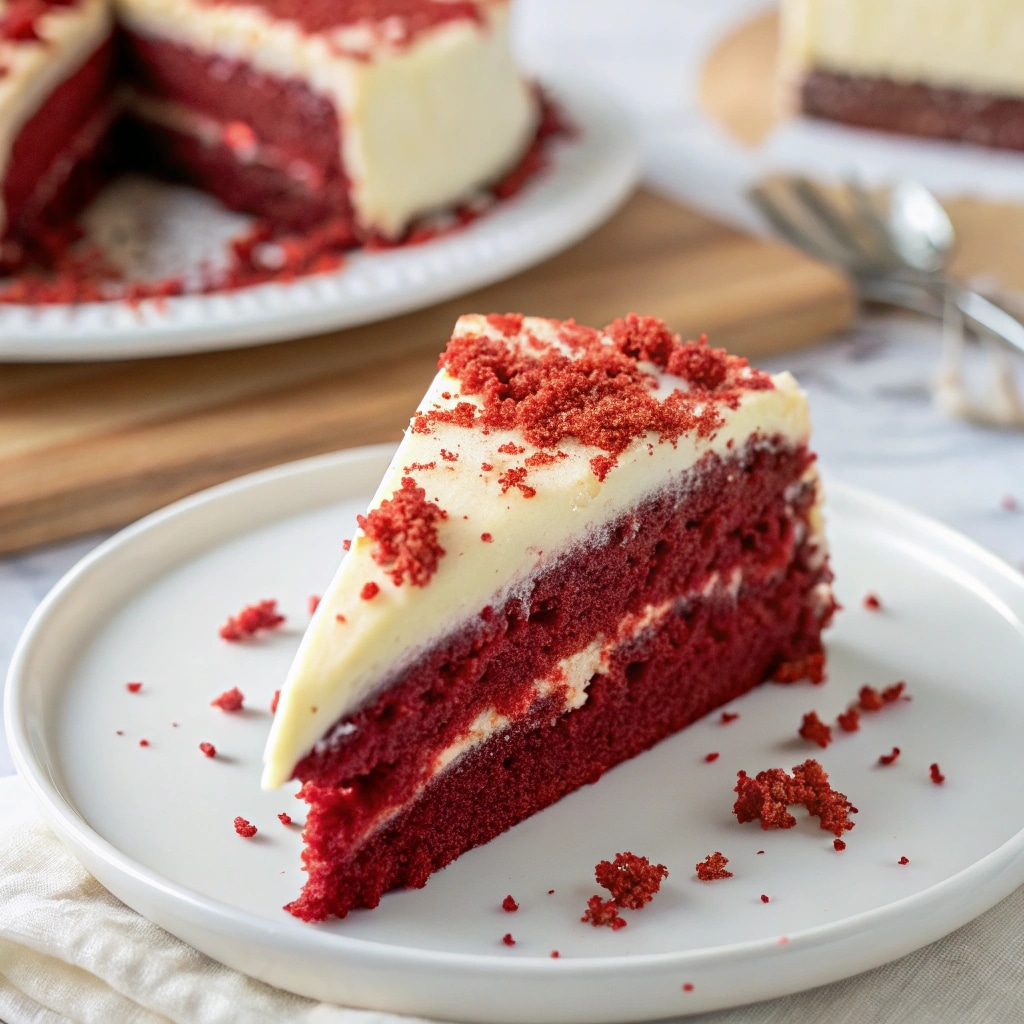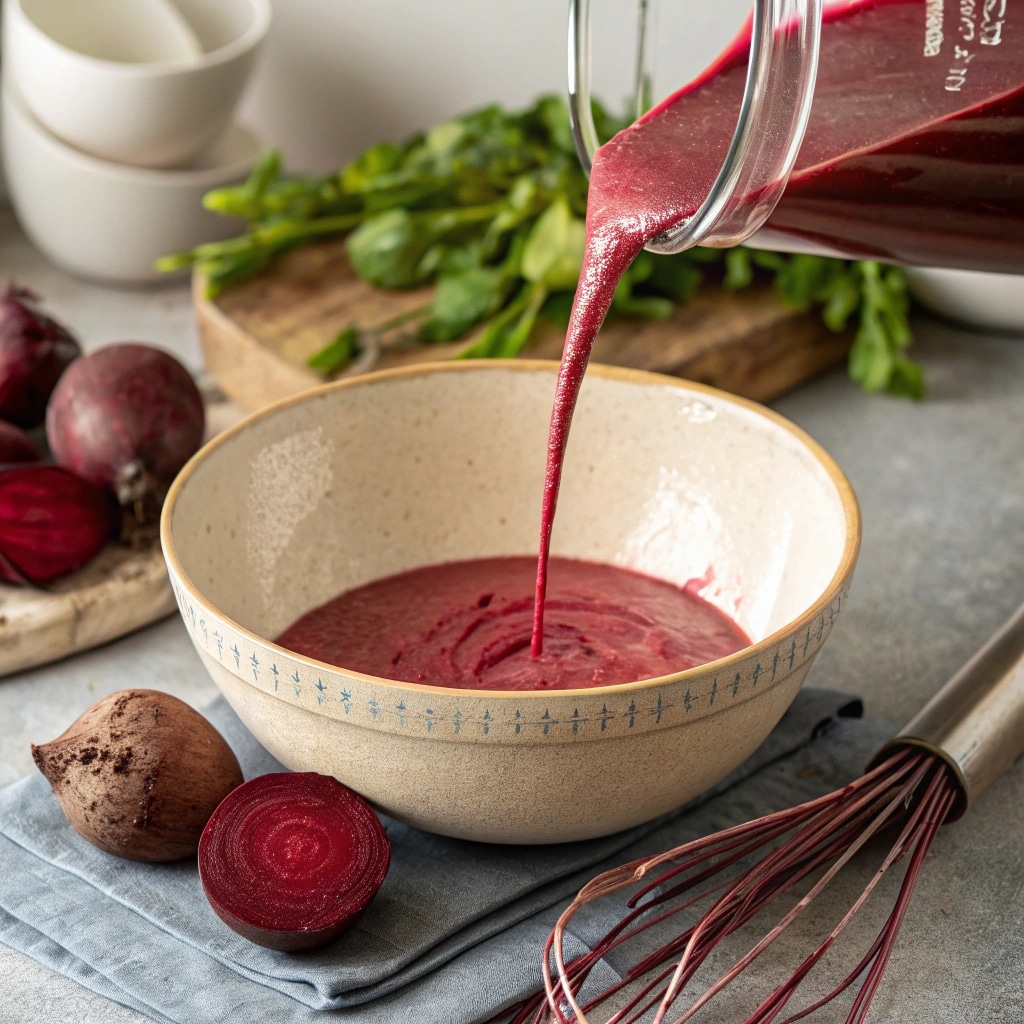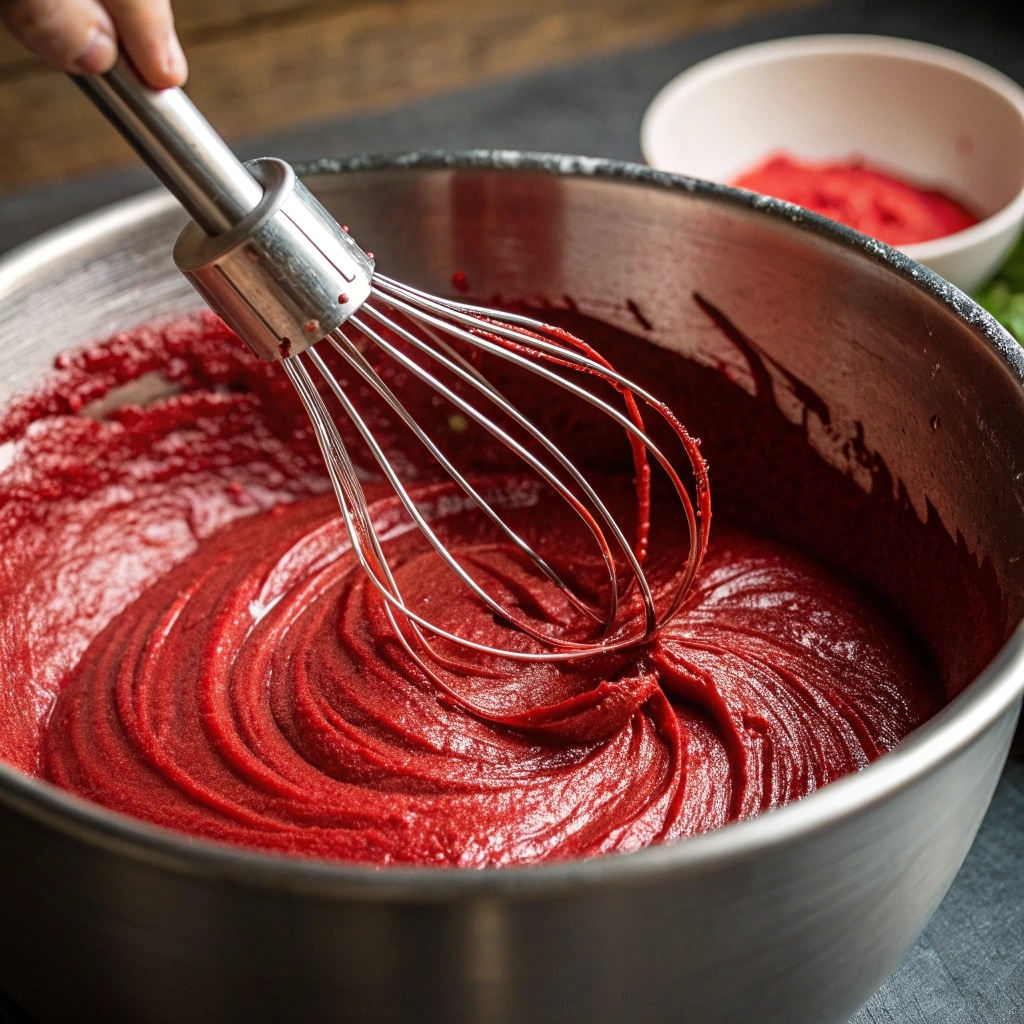Baking a true red velvet cake is more than mixing cocoa, sugar, and flour—it’s about capturing that unmistakable, vivid scarlet hue that turns a slice into a showstopper. In this guide, you’ll learn everything from the history of red velvet’s signature shade to the science behind achieving it, plus how to choose between liquid, gel, and natural dyes. I’ll even share how I once went from dull pink disasters to bakery-worthy reds at Sweet Magnolia, with tips you can try right away. If you’re starting from scratch, my how to bake a cake tutorial is the perfect foundation.

Table of Contents
Understanding the Role of Red Food Colour in Red Velvet Cake
History of Red Velvet Cake’s Signature Color
The origin of red velvet’s signature color goes back to the early 1900s, when bakers noticed that natural cocoa reacted with acidic ingredients like vinegar and buttermilk, producing a reddish-brown crumb. During the Great Depression, food coloring brands popularized a brighter red by promoting bottled dyes as a way to make cakes more appealing. Today, whether you use red velvet waffle cake batter or classic layered style, that color is part of the cake’s identity—symbolizing indulgence, nostalgia, and celebration.
Why Red Food Colour is Essential for Authentic Red Velvet Cake
While the cake’s flavor is a delicate balance of cocoa and tangy dairy, its striking red appearance elevates the experience. The right red food colour for red velvet cake doesn’t just add drama—it compensates for modern cocoa powders that no longer yield much natural redness. A consistent, vivid red ensures your cake looks as good as it tastes. It also sets expectations for flavor, making every slice feel special, whether served at weddings, birthdays, or just because.
Types of Red Food Colouring You Can Use
Liquid Food Colour vs. Gel Food Colour: Pros and Cons
When I first experimented with different dyes for my red velvet creations, I quickly learned that liquid and gel food colours behave very differently in batter. Liquid food colouring is easy to measure and blend, making it beginner-friendly, but you’ll often need a larger quantity to achieve deep color. This can slightly thin your batter, which may affect the cake’s rise. Gel food colouring, on the other hand, is concentrated and produces a bright red cake colour with just a small amount. Because it doesn’t add excess moisture, gel is preferred by many professional bakers—especially for recipes like my red velvet cookies from box cake mix, where consistency matters in both color and texture.
Natural vs. Artificial Red Food Colour – Which Works Best?
Artificial red dyes, such as Red No. 40, are popular for their intensity and reliability. They stay vibrant even after baking, resisting fading in the oven’s heat. However, if you’re aiming for a more wholesome ingredient list, natural food colours are worth considering. These can be made from concentrated plant-based sources like beets, hibiscus, or pomegranate. While natural dyes give a gorgeous, earthy red tone, they can sometimes shift toward brown when exposed to high heat, making them trickier to work with.
For bakers looking for a balance of vibrance and clean labeling, blending natural colouring with a touch of artificial dye can give the best of both worlds—much like pairing a classic layer cake with a playful red velvet cake Oreo cookies twist.
Choosing the Best Red Food Colour for Baking
What to Look for in High-Quality Red Food Colour
Not all red dyes are created equal. A good red food colour for red velvet cake should be heat-stable, meaning it retains vibrance even after prolonged baking. Look for brands that specifically label their colours as “bake-safe” or “heat-resistant.” The dye should also be concentrated enough that you only need a small amount—this helps avoid any bitter aftertaste. Ingredients matter too: a shorter, cleaner label often means fewer unnecessary additives. If you’re experimenting with different recipes having a reliable colouring on hand can make your results far more predictable.
Top Brands for Red Velvet Cake Coloring
| Brand | Type | Pros | Cons |
|---|---|---|---|
| AmeriColor Super Red Gel | Gel | Highly concentrated; vibrant colour; heat-stable | May stain hands and tools |
| Wilton No-Taste Red | Gel | Rich hue without bitter aftertaste | Slightly less intense than other gels |
| Chefmaster Liqua-Gel Red | Liqua-Gel | Easy to mix; bold colour; good for large batches | Slightly more liquid content may thin batters |
| Beetroot Powder (Natural) | Powder | Plant-based; no artificial additives | Can shift brown when baked at high heat |
How to Achieve the Perfect Shade of Red
Measuring and Mixing for Consistent Color
The secret to a flawless red food colour for red velvet cake lies in accuracy and preparation. Always start with a precise measurement—especially if you’re using concentrated gels or powders. For best results, incorporate the dye into your wet ingredients before adding dry ones. This helps the colour disperse evenly, giving you a uniform crumb without streaks. If you’re using powdered natural colour, dissolve it in a small amount of warm water or oil first. This extra step avoids clumping and ensures your batter blends smoothly into that sought-after, rich red tone.
Tips to Avoid a Bitter Aftertaste
A common pitfall for bakers aiming for a bold shade is adding too much dye, leading to a chemical or bitter aftertaste. To sidestep this, choose a high-strength or “no-taste” formula so less is needed. Pair your dye with lighter cocoa powders, as darker cocoa can overpower your colour and push you to overcompensate with more dye. Moderate oven temperatures are also key; extreme heat can alter both the hue and flavour. For those experimenting with new recipes—like layered cakes with unique fillings—start with less dye than you think you need, then adjust gradually until you reach your ideal vibrance.
Making Your Own Natural Red Food Colour
Beetroot Juice Method for Red Velvet Cake
If you’re looking for a natural food colour for red velvet cake, beetroot juice is a time-tested choice. It delivers a rich, earthy red without artificial additives. To make it, peel and chop fresh beets, then blend them with a small amount of water until smooth. Strain through a fine mesh or cheesecloth to extract pure juice. For more intensity, reduce the juice over low heat until slightly thickened—this concentrates the colour and helps it hold during baking. When adding to batter, incorporate the juice with your wet ingredients to ensure even colouring.

Other Natural Ingredients That Give a Rich Red Hue
| Ingredient | Colour Intensity | Best Use | Notes |
|---|---|---|---|
| Beetroot Juice | Deep, earthy red | Batter colouring | May darken slightly with heat; add acid to stabilize |
| Hibiscus Petal Infusion | Bright crimson | Frostings, glazes | Steep petals in hot water; less stable in baked goods |
| Pomegranate Juice | Pink-red | Light cakes, frostings | Can lose vibrance when baked; better for no-bake desserts |
| Freeze-Dried Raspberry Powder | Dusty pink to red | Batter, buttercream | Adds tangy flavour; stable at lower baking temps |
Common Problems with Red Food Colour in Baking
Why Your Red Velvet Cake Turns Brown
One of the most frustrating issues with red food colour for red velvet cake is when your vibrant batter bakes into a dull brown. This often happens when the oven temperature is too high, causing the colour pigments—especially in natural dyes—to break down. Excess cocoa powder can also muddy the hue, overpowering the red. For consistent results, measure cocoa precisely and bake at the recipe’s recommended temperature, checking with an oven thermometer to ensure accuracy.
Fixing Faded or Dull Cake Colors
If your cake emerges lighter than expected, the culprit could be insufficient dye concentration or uneven mixing. Using a concentrated gel or liqua-gel ensures stronger pigmentation that survives baking. For natural dyes, slightly over-saturate your batter before baking, as some colour loss is inevitable. Another trick is adding a touch of vinegar or lemon juice—the acid helps stabilize red pigments, especially when working with plant-based colour sources. For frosted cakes, applying a thin “crumb coat” in matching colour can visually enhance vibrancy in the final presentation.
Step-by-Step Guide to Adding Red Colour in Your Recipe
When to Add the Food Colour for Best Results
Timing is everything when working with red food colour for red velvet cake. For the most even and vibrant results, add your dye to the wet ingredients—usually after combining oil or butter, sugar, eggs, and any liquid components. This ensures the pigment disperses thoroughly before the dry ingredients are incorporated. If you add colour after combining wet and dry, you risk streaks or uneven tones. For natural dyes like beet juice, mix with an acid (such as vinegar or lemon juice) during this stage to lock in vibrance.

Baking Temperature and Color Preservation
Even the perfect batter can lose its brilliance if baked incorrectly. High heat can cause both natural and artificial dyes to fade or brown. Stick to your recipe’s suggested baking temperature—typically around 350°F (175°C)—and check your oven with a thermometer for accuracy. If you’re using natural colours, consider lowering the temperature by 10–15°F and extending baking time slightly to minimize pigment breakdown. This slower, gentler bake helps maintain that showstopping red all the way through the crumb.
Red Food Colour Substitutes and Alternatives
Using Pink or Burgundy Shades for a Twist
If you want to give your red velvet a creative edge, consider experimenting with shades like soft pink or deep burgundy. Pink tones can be achieved by using less dye or opting for lighter natural pigments such as raspberry powder or strawberry puree. Burgundy shades work well for elegant occasions and can be created by combining a smaller amount of red food colouring with a touch of blue or purple gel dye. These variations can still provide visual impact while offering a unique twist on the classic.
Cocoa Powder Adjustments for Red Velvet Recipes
Cocoa powder plays a surprisingly big role in how your colour appears. Traditional red velvet recipes use only a small amount of cocoa to keep the red vibrant, but increasing cocoa can push the tone toward maroon or brown. If you’re short on red dye, slightly reducing cocoa and adding an acid like vinegar can help coax more natural red hues from the cocoa itself. For alternative shades, you can blend different cocoa types—Dutch-processed for deeper tones or natural cocoa for lighter reddish-brown crumbs.
Best Practices for Safe and Healthy Consumption
Food Safety Tips for Artificial Colours
Artificial dyes like Red No. 40 are approved for use in baking, but it’s best to follow the manufacturer’s recommended usage amounts. Overuse not only risks a bitter aftertaste but can also increase unnecessary chemical intake. Always store artificial dyes in a cool, dry place away from direct sunlight to prevent degradation. If baking for children or individuals with dye sensitivities, consider opting for a “no-taste” or allergen-free variant to minimize any adverse reactions.
Natural Dye Storage and Shelf Life
Natural dyes, while wholesome, have shorter shelf lives than their artificial counterparts. Fresh beet juice should be used within a day, while powdered plant-based dyes can last several months if kept in airtight containers away from light and moisture. Hibiscus infusions and fruit powders should be refrigerated if not used immediately, to preserve both their vibrance and safety. Always label homemade dyes with the preparation date to keep your baking both beautiful and safe.
FAQs: Red Food Colour for Red Velvet Cake
Which red food coloring is best for red velvet cake?
For vibrant, heat-stable results, concentrated gel options like AmeriColor Super Red or Wilton No-Taste Red are top picks. If you prefer natural dyes, beetroot powder is the most reliable, though it may need acid for colour stability.
What is the red color in red velvet cake?
Traditionally, it came from a chemical reaction between cocoa and acidic ingredients. Today, most bakers boost or replace this natural tone with food colouring—either artificial gels or natural plant-based dyes.
How to make red color for red velvet cake?
For artificial colouring, mix concentrated gel or liqua-gel into your wet ingredients before adding dry. For a natural option, use concentrated beet juice reduced over low heat, blending with an acid to lock in vibrance.
Conclusion
Achieving the perfect red food colour for red velvet cake is as much an art as it is a science. From understanding the history of this iconic hue to choosing between gels, liquids, and natural alternatives, every decision shapes your final result.
Whether you prefer the precision and vibrance of professional gel dyes or the earthy charm of beetroot and hibiscus, the key lies in measuring carefully, baking at the right temperature, and pairing your colour choice with the right cocoa. With the tips, troubleshooting advice, and step-by-step guidance shared here, you’re ready to bake a red velvet cake that’s as striking to look at as it is delicious to eat. So preheat that oven, choose your favourite colouring method, and bring that stunning red to life—slice after slice.
Want more sweet inspiration? Follow me on Facebook and Pinterest where I share cozy, easy-to-make baking recipes just like this one. Every bite is a warm hug. Let’s bake something beautiful together.
